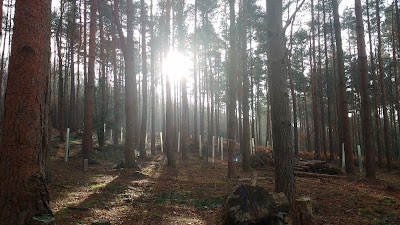Yesterday, two days before the end of the strange year that was 2016, we spent a few hours at Old Copse, not doing very much except checking in with the wood. We re-stacked lengths of birch firewood, heated up soup, toasted marshmallows in the log burner, and 'beat the bounds'. All the trees are now bare, and the bracken well and truly flattened, revealing the piles of brash left after the thinning operation. Mist rose from the pond, which was covered in a thin layer of ice.
And while we walked we made a mental note of the woodland management tasks we've achieved this year :
and then planned our woodland management tasks for 2017:
Several people have asked how the two of us, visiting the wood on average twice a week, manage the work necessary to restore Old Copse. I suppose it must seem like a daunting task to someone who isn't as familiar with the wood as we are, but we seem to have found a rhythm that suits us. We have recognised that we can't easily manage to do all the 'heavy' work ourselves, without perhaps losing momentum and ending up feeling a bit overwhelmed. So we find people with woodland skills, willing to help us in exchange for what the woodland can offer them. This approach works well. We tackle what we can, and get help when we need it.
Management Plans are ok as far as they go, but they are usually written at the start of a project, and can only be based on what you know at that point. They are good for setting out the general direction and certainly, our aim, as stated in the original plan - to restore the woodland and improve diversity - has not changed at all. In fact the more we learn about Old Copse - the more determined we are to achieve this. As things progress we've found that we've modified our ideas, and done loads of work that isn't even mentioned in our plans. The Woodland Management Plan has been good for setting targets and has helped us keep on track. We have returned to it - and not just to put in grant claims to the FC - but to remind ourselves of how all the little tasks fit together into the bigger picture. Work doesn't stop after the end of a five year management plan; on the contrary, work in the wood is never finished as the wood is dynamic and ever-changing. This might be seen as a bit dispiriting, but for me the sheer power of the wood to change and keep changing is one of the most wonderful things about it.
And while we walked we made a mental note of the woodland management tasks we've achieved this year :
- Started the year by 'mattocking' the deep, mud filled ruts made by the Scots Pine thin machinery.
- Continued thinning the thick holly
- Pollarded the north side of the willow grove
- Propagated successfully 50 trees and shrubs from seeds and seedlings found in the wood
- Protected 100 regenerating trees from fallow deer
- Planted over 400 trees in the thinned Scots Pine
and then planned our woodland management tasks for 2017:
- Finish planting in the thinned Scots Pine (January/February)
- Tackle halo thinning in the birch wood (January/February- August to November)
- Spot replanting in the birch wood (November /December)
- Finish the holly thinning (by the end of 2017)
- Pollard the south half of the willow shoots in the willow grove (November )
- Plant a mixed hedge along the border with Grouse Road (December)
- In addition to these main tasks, there is bracken clearance from late May to September, fence mending and maintenance, monitoring deer and squirrel impact, continuing to protect regenerating broadleaves, ride maintenance, ditch digging ...
Several people have asked how the two of us, visiting the wood on average twice a week, manage the work necessary to restore Old Copse. I suppose it must seem like a daunting task to someone who isn't as familiar with the wood as we are, but we seem to have found a rhythm that suits us. We have recognised that we can't easily manage to do all the 'heavy' work ourselves, without perhaps losing momentum and ending up feeling a bit overwhelmed. So we find people with woodland skills, willing to help us in exchange for what the woodland can offer them. This approach works well. We tackle what we can, and get help when we need it.
Management Plans are ok as far as they go, but they are usually written at the start of a project, and can only be based on what you know at that point. They are good for setting out the general direction and certainly, our aim, as stated in the original plan - to restore the woodland and improve diversity - has not changed at all. In fact the more we learn about Old Copse - the more determined we are to achieve this. As things progress we've found that we've modified our ideas, and done loads of work that isn't even mentioned in our plans. The Woodland Management Plan has been good for setting targets and has helped us keep on track. We have returned to it - and not just to put in grant claims to the FC - but to remind ourselves of how all the little tasks fit together into the bigger picture. Work doesn't stop after the end of a five year management plan; on the contrary, work in the wood is never finished as the wood is dynamic and ever-changing. This might be seen as a bit dispiriting, but for me the sheer power of the wood to change and keep changing is one of the most wonderful things about it.





























